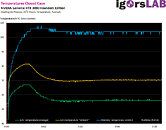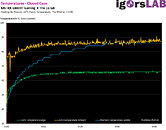Wednesday, February 17th 2021

NVIDIA GPUs Have Hotspot Temperature Sensors Like AMD
NVIDIA GeForce GPUs feature hotspot temperature measurement akin to AMD Radeon ones, according to an investigative report by Igor's Lab. A beta version of HWInfo already supports hotspot measurement. As its name suggests, the hotspot is the hottest spot on the GPU, measured from a network of thermal sensors across the GPU die, unlike conventional "GPU Temperature" sensors, which reads off a single physical location of the GPU die. AMD refers to this static sensor as "Edge temperature." In some cases, the reported temperature of this sensor could differ from the hotspot by as much as 20°C, which underscores the importance of hotspot. The sensor with the highest temperature measurement becomes the hotspot.
GPU manufacturers rarely disclose the physical locations of on-die thermal sensors, but during the AMD Radeon VII, we got a rare glimpse at this, in a company slide, with the sensors being located near components that can get the hottest, such as the compute units (pictured below). Igor's Lab put out measurements of the deviation between the hotspot and "GPU temperature" sensors on a GeForce RTX 3090 Founders Edition card. There's a much narrower deviation between the two (between 11-14°C), and than the one between hotspot and Edge temperature on an MSI Radeon RX 6800 XT Gaming X Trio (which posts a 12-20°C difference).
Source:
Igor's Lab
GPU manufacturers rarely disclose the physical locations of on-die thermal sensors, but during the AMD Radeon VII, we got a rare glimpse at this, in a company slide, with the sensors being located near components that can get the hottest, such as the compute units (pictured below). Igor's Lab put out measurements of the deviation between the hotspot and "GPU temperature" sensors on a GeForce RTX 3090 Founders Edition card. There's a much narrower deviation between the two (between 11-14°C), and than the one between hotspot and Edge temperature on an MSI Radeon RX 6800 XT Gaming X Trio (which posts a 12-20°C difference).



44 Comments on NVIDIA GPUs Have Hotspot Temperature Sensors Like AMD
Talk about a stretch! Some people will take every opportunity to crap on miners for literally no reason other than spite, I guess...
Yes, it will help miners, but it'll also help gamers lol... it's not a mining-focused feature in any way, shape or form...
Hot spot temp is better IMHO, would better explain why people are getting stutters in game.
Feature is AWESOME, but why now?
"Added monitoring of GPU HotSpot temperature for NVIDIA GPUs"
- www.hwinfo.com/forum/threads/hwinfo-v6-43-4380-beta-released.7084/#post-29119
If we want to be cynical, I think it's actually the water block manufacturers who got this added :-D
Looks like the massive coolers are just as much for GDDR6X as it is for the GPU.
@W1zzard any plans of implementing this in GPU-z in any upcoming versions?
You see that 200W power listed there. 150W of it is just for the GDDR6X. Ampere is efficient but that GDDR6X gets really hungry and hot fast. Traditional cooling is not enough to cool these cards at full 100% load without some sort of mods.
Adding the additional info is a good thing. hopefully it will allow for better insight and longer lasting cards in the future. (I really think the key metric should be the hotspot temp, not the average or whatever they currently use).
A delta that is too much can indicate improper mounting pressure, cold plate flatness or just an uneven mount in general.
For daily users, I think the benefit is it help reviewers to provide the info. Hopefully buyers do some research before buying.